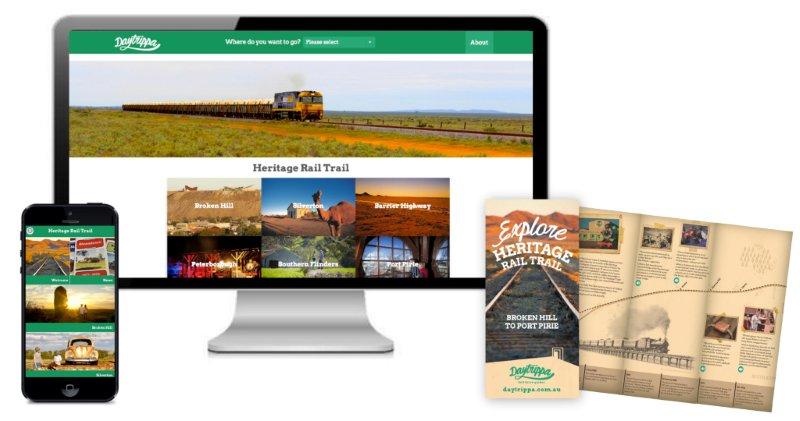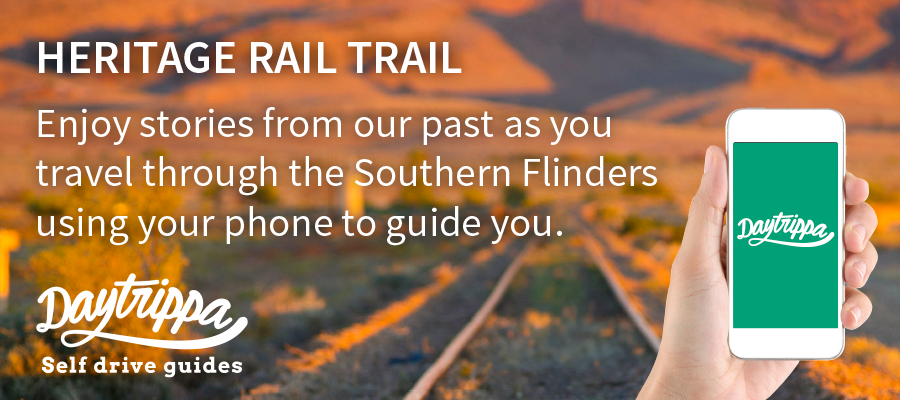SILVER TO SEA WAY (PREVIOUSLY KNOWN AS THE HERITAGE RAIL TRAIL)
Three-quarters of a million people drive past it each year – a lowly red embankment stripped of sleepers and rails – all that remains of the narrow gauge rail line that helped transform a nation.
Just like the story, it starts in the broken escarpments of outback New South Wales, gradually descending through a string of dying railway towns in South Australia to end 400km away at the pale blue gulf waters of Port Pirie.
In 1883, seven ordinary men – station hands and dam diggers among them – staked seven mining claims on the Mt Gipps sheep station near Silverton. The ‘Syndicate of Seven’ worked their leases using money they could ill-afford but within two years their small operations were beginning to surrender samples that were fat with silver.
On July 17, 1885, the Syndicate of Seven – now expanded to a Syndicate of 14 – sat around a table in de Braun’s pub in Silverton to raise capital for a mine by floating a new company.
They called it Broken Hill Proprietary Limited.
The world’s biggest deposit of silver, lead and zinc quickly proved itself and a city sprang out of the semi-arid scrub. Broken Hill was beset by heat, dust and water shortage, but these were nothing to the challenges of isolation. The nearest port was not Sydney to the east but Port Pirie to the west, at the head of the Gulf St Vincent in South Australia, a punishing trek by bullock dray and horse carriage.
Some hope was held out when the South Australian government, slowly extending a narrow gauge railway into the remote pastoral districts, offered to drive a line to the border and cross 50km into New South Wales to service the mines of Silverton and Broken Hill.
The NSW government in Sydney however was having none of this and flatly refused its neighbour permission to lay track past the border.
Just weeks after the formation of BHP, three of the new directors got behind a plan to thwart the Sydney bureaucrats. They formed a private ‘tram company’ to go around colonial regulations and drive a ‘Silverton Tramway’ 50km to the border.
Three years later, the final dog spike was driven home and the ‘tramline’ was joined to a fresh narrow gauge line at the South Australian border town of Cockburn. The BHP men now had a clear run to Port Pirie – and Australia’s greatest mining boom was underway.
Technically the 3’6” line was an engineering triumph, overcoming fierce gradients as well as sandstorms, floods and locust plagues that greased rails and caused locomotives to slip. But as a commercial venture the line was a minor miracle, turning at least £17m in 50 years and quickly becoming one of the most profitable stretches of railway in the world.
It became so busy with freight that whole towns of railway people were needed to run and maintain it, towns like Yunta, Oodla Wirra and Cockburn. More powerful locos were brought into service and the largest town on the route, Peterborough, became the nation’s steam heartland, marshalling so many engines that the local climate was actually warmed.
In 1892 BHP acquired the British Broken Hill smelting works in Port Pirie and in 1897 erected new smelters – an operation so large that Australia became independent of foreign processing, a critical development with the advent of World War One. The ingots of lead, silver and zinc went off to all corners of the British Empire, marking the end of the line for the ore and the beginning of Australia’s transformation from an agricultural to an industrial economy.
Today the little railway line has almost disappeared from sight and the railway towns are in decline or gone altogether. But the legacy is a powerful one. In its heyday, Broken Hill-to-Pirie kept the railways profitable and helped carry South Australia through the depressions of 1890 and 1929; it also financed the continued business of building railways in challenging arid lands. In 1927, Australia finally had a string of rail lines connecting Sydney with Perth.
And in the middle of that was the Broken Hill line.
On July 17, 2015, it will be 130 years since the Syndicate men first wrote the name ‘Broken Hill Proprietary Limited’ at a table in de Braun’s pub in Silverton. Today, the Indian Pacific train and the speeding vehicles of the Barrier Highway continue to run alongside the 3’6” relic in the red dirt, oblivious to its presence and to the significance it holds for a modern nation.
So to experience this fascinating Heritage Rail Trail, simply click here to go straight to the home page on the mobile guide: www.daytrippa.com.au/heritage-rail-trail/full-guide/home/ or click here to go to the Daytrippa home page to see their full suite of mobile guides, which includes Peterborough and the Heritage Rail Trail: www.daytrippa.com.au
The mobile guide will provide you with maps, stories, audio content and much much more to help you explore this historic trail. You can also pick up a brochure all along the trail, or download it below.
Click here: Heritage Rail Trail Brochure (8544 kb) to download the brochure.
(8544 kb) to download the brochure.
Click below to view the Heritage Rail Trail featured on Channel 7's prime-time SA Weekender travel show, aired 17th September 2017.
Click here: Heritage Rail Trail Radio (2830 kb) to listen to the Peterborough Tourism Manager, with Peter Goers on ABC Radio Adelaide (6th Feb 2015), discussing the Heritage Rail Trail.
(2830 kb) to listen to the Peterborough Tourism Manager, with Peter Goers on ABC Radio Adelaide (6th Feb 2015), discussing the Heritage Rail Trail.
Click here: HRT Radio Interview (6241 kb) to listen to the Peterborough Tourism Manager, with Ron Kandalaars on ABC Radio (26th Oct 2016), discussing the Heritage Rail Trail.
(6241 kb) to listen to the Peterborough Tourism Manager, with Ron Kandalaars on ABC Radio (26th Oct 2016), discussing the Heritage Rail Trail.


